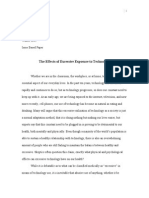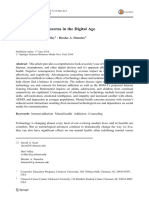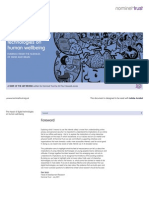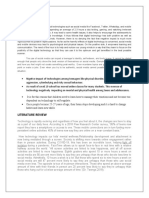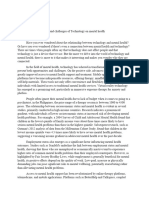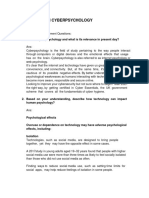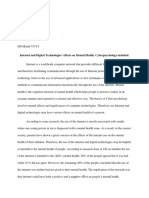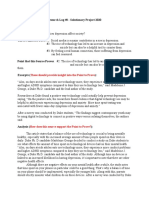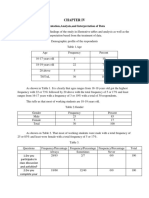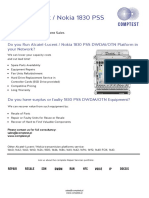Chapter I
The Problem and Its Background
Introduction
All manner of technology surrounds us. From our personal laptops, tablets and phones to behind-
the-scenes technology that furthers medicine, science and education.
Technology is here to stay, but it’s always morphing and expanding. As each technology enters the
scene, it has the potential to improve lives. But in some cases, it also has the potential to negatively
affect physical and emotional health. Using social media can make you feeling adequate or left out.
(Pietrangelo, 2019)
Digital behavioral health is increasingly viewed as a way for organizations to improve patients’
overall health, reduce unnecessary and expensive hospitalizations. and comply with laws requiring
insurers to provide mental-health benefits at the same level as benefits for other medical care.
Some technologies are narrowly focused, such as cognitive therapy sessions that people do on their
own, like they might use an online program to learn a foreign language. There are also myriad
smartphone applications designed to help people track and manage their emotions. Some can alert
a provider of a possible problem by monitoring how much an individual moves around or talks to
others that day. (Sun, 2015)
With the changes smart technology and social media have made in our culture, it’s not surprising
that there are some naysayers. But there are legitimate concerns regarding mental health and our
increased use of technology. Let’s face it, you’re reading this on a screen. Your browser probably
has multiple windows pulled up, one of them very possibly being Facebook. Maybe you have
another screen on in the room playing a video — this author certainly does.
Studies show that pre-teens and early teenagers using smartphones more frequently have trouble
focusing and that symptoms and effects of disorders like ADHD worsen. While some believe that
that social media can decrease loneliness, some studies seem to point toward a connection
between depression and smartphone/social media usage. Even if depression isn’t a direct result of
1
�technology usage, there are still arguments for things that lead to depression resulting from too
much smartphone usage — such as isolation from the real world and addiction to the fast-paced
nature of the internet. (Rue, 2018)
Background of the Study
One of the most dramatic impacts of technology is the decline of the quality and quantity of sleep.
The sleep chemical melatonin is influenced by the constant glow from screens. So keeping
technology is likely to interfere with your sleep and effects your general state. What is even more
serious is that people become addicted to technology. This has a detrimental effect on person’s
health and social life, and destroys social and family bonds. Among other mental problems caused
by computers is a new type of stress called The chronic Smartphone Stress. It is caused by
notifications (or their absence), constant anticipation of a message or e-mail. If a person doesn’t
get enough attention, this can make you feel stressed or even depressed. Excessive information
space, exaggerated online reality, internet overuse, and social comparison are all factors potentially
provoking depressive behavior.
Look around the next time you’re at a restaurant. You’ll see toddlers on iPads, kids posting on
Instagram, and adults whose phones are placed right next to their plates, ready to be picked up at
the first ding, buzz or ring.
A study done at Duke University found that, on days they use technology more, at-risk adolescents
experienced more conduct problems and higher ADHD symptoms compared to days they used
technology less. On the flip side, the study also found that those same adolescents experienced less
depression and anxiety on days they used technology more. A University of Michigan study found
that Facebook use led to a decrease in happiness and overall life satisfaction. Research coming out
of the University of Gothenburg in Sweden found a link between heavy cell phone use in young
adults and depressive symptoms.
2
�A team of Australian researchers conducted two studies and found that compulsive internet use by
adolescents leads to poorer mental health. A Swansea University study found that heavy internet
users experience psychological symptoms of withdrawal when they stop using.
Those studies raise some interesting points, but they also raise more questions. For example, does
technology have the same impact on children, adolescents and adults? Or is it more detrimental to
the developing brain? How much screen time is too much screen time? And are some forms of
technology, like social media, worse than other kinds, like answering work emails?
The fact is, technology has evolved so fast that we really don’t have it all figured out yet. To be
sure, there will be many more studies done going forward that may help us better understand how
technology affects mental health. In the meantime, however, there’s no disputing that tablets, cell
phones and computers are all here to stay. But there are a few common-sense steps we can all
take—and that experts recommend. (Team, 2018)
Statement of the Problem
1. What is the demographic profile of the respondents in terms of :
a. Age;
b. Gender; and
c. Strand or level
2. What are the effects of technological devices to the students mental health specifically in:
a. Emotional;
b. Psychological; and
c. Social well-being
3. Is there a significant positive effect of technological devices?
4. Is there a certain negative impact of technological devices?
3
�Null Hypothesis
In this study, the researchers assume that there is no statistically significant relationship between
the technological devices on the mental health of Grade 11 ICT students A.Y. 2019 - 2020 of St.
Jude College Dasmariñas Cavite. The type of hypothesis used is Null Hypothesis. A null
hypothesis used in statistics that proposes that no statistical significance exist in a set of given
observations. The null hypothesis attempts to show that no variation exists between variables or
that a single variable is no different than its mean. It is presumed to be true until statistical
evidence nullifies it for an alternative hypothesis. (Hayes, 2019)
Significance of the Study
Determining the Effect of Technological Devices on the Mental Health of Grade 11 ICT Students
A.Y. 2019 – 2020 of St. Jude College Dasmariñas Cavite has its importance and/or potential
benefit to:
Students. Students can learn important things about the effect of technological devices as they
read this study and are able to apply it on themselves. They will know its effects on their mental
health and may be able to prevent or take immediate action towards the possible issues of using
technological devices.
Parents. This study will raise awareness to the parents and may help them control their children’s
exposure to gadgets. They may also seek early consultations to specialists if they already see
specific symptoms on their child’s mental health.
Teachers. Teachers can teach or persuade their students to control and be more knowledgeable on
the amount of time of using technological devices as it may leave an impact to them. They can
show the possible effects of having bad habits towards the said topic.
Future Researchers. This study can help the future researchers as they conduct their own research
relative to the topic. This can serve as a related study and as an inspiration to guide them through.
The study could also motivate some researchers in starting a study connected to this subject.
4
�Scope and Delimitation
The study focuses on The Effect of Technological Devices on the Mental Health limited to the
Grade 11 ICT Students of St. Jude College Dasmariñas Cavite A.Y. 2019 – 2020.
Theoretical Framework
What are the theoretical and practical implications of the current study? Whereas the perspective
of technological determinism argues that negative social effects occur regardless of how people
use electronic communication technology, because it strips away personal and social cues or
provides new capabilities, the rational actor perspective argues that some of the negative social
effects may be outcomes that people deliberately intend to achieve, and that users might anticipate
the medium's risks and take steps intended to ward off negative effects. In some cases, these
prophylactic behaviors may actually be effective; thus, the rational actor perspective can help
explain, better than the technological determinist perspective, why negative social effects might
accompany the use of a particular technology in some settings and positive effects might occur in
others. This suggests that researchers should intensify efforts to identity, and educate users about,
the “good” and the “bad” ways to use e-mail and other communication technologies. But the
current study also shows that deliberate measures taken to avert negative outcomes may not always
succeed—that such outcomes can be an ironic byproduct of “good” behavior. Thus, the emergent
process perspective helps to explain, better than the technological determinist perspective, how
negative effects might occur in unexpected places, for instance, in relationships among those who
communicate face-to-face, not just among those who communicate via e-mail. Further, this
perspective suggests that it may be inappropriate to blame users for all the observed negative social
effects of electronic communication technology and that technical enhancements or improved user
education may have little effectiveness at eradicating them. The emergent process perspective
cautions us that the prospects for achieving socially desirable outcomes are dim, as long as social
scientists, technology designers, and users cling to simple theories that attribute all social
consequences directly to technology or to users. The results of this study imply that, however
advanced our communication technologies may become, however much they may incorporate the
5
�sense of “being there” or even move beyond it (Hollan and Stornetta, 1992), their effects will
always depend, at least in part, on how people understand these technologies and on how they
choose to use them. At the same time, however, the complex, systemic interactions between people
and technologies ensure that the social effects of electronic communication may continue to appear
“puzzling, evasive, and hard to pin down” (Pool, 1978, p. 4). (Kline, 2015)
Definition of Terms
Devices – an object that has been made for special purpose.
Emotional – relating to or showing emotions.
Health – the condition of being well.
ICT – Information and Communication Technologies
Mental – relating to the state of mind or total emotional and intellectual response.
Psychological – it is related or relating to the study of mind
Social Media – the most common application used by technological devices
users.
Technological Determinism – a theory that argues about the negative effect of
technological devices regardless of its user.
Technological Devices – devices made from technology such as smart phones
and tablets.
Technology – a machine, or piece of equipment invented to be useful.
User – a person or thing that uses something.
6
� Chapter II
Review of Related Literature
Foreign Literature
Although digital technologies can provide young people with many benefits, many adults have
expressed concerns about some kids’ online behaviors, safety and privacy – as well as the amount
of time that young people spend with their phones and other electronic media. Those who care
about the well-being of kids may also be interested in exploring how the overuse of digital
technology may negatively affect the mental health of young people (and adults).
Michigan State University Extension recently provided a webinar titled This is your brain online:
The impact of digital technology on mental health. The webinar featured Scott Becker, director of
the MSU Counseling Center, who shared research findings of ways that the overuse of digital
technology may affect brain development, sleep, mood, concentration, memory, learning and
relationship behaviors. According to Dr. Becker, university counseling centers across the country
have seen dramatic increases in the numbers of students seeking help with serious mental health
issues. While there may be many explanations related to these increases (for example, there’s less
stigma about seeking mental health services), Dr. Becker stressed that the overuse of social media,
video games and other digital technologies may be contributing to these increases. Following are
highlights from some of the areas that Dr. Becker discusses in the webinar.
The overuse of digital technology in all its forms (such as phones, tablets, laptops, game consoles
and television sets) can negatively affect the quantity and quality of our sleep. This may be due to
frequent interruptions during sleep from incoming texts or social media notifications. It’s also
related to ways that our biological and nervous systems react to the light levels produced by these
devices – particularly when we use them before bedtime. Our bodies can also react to the
electromagnetic signals used with cell phones. Dr. Becker stressed that sleeping with a cell phone
within reach means that our bodies are also taking in these signals in ways that can negatively
affect the quality of sleep. By changing habits related to sleeping near cell phones and using digital
7
�devices before bedtime, we may see important improvements in our sleep, which is critical to our
overall health and well-being.
Being interrupted frequently is a common experience for many of us in our daily lives but frequent
and ongoing interruptions are even more common for people who are heavy users of digital
devices. Some research has shown that the excessive use of texting and time spent online
contributes to mental fatigue and increased problems with memory, attention, concentration and
learning – particularly learning at a deep level. It may take us longer to carry out tasks (such as
homework or a work project), and we may make more mistakes in the process. The ways in which
we take in information on the Internet is different from “traditional” types of reading. When we
take in information online, we encounter a variety of visual and auditory information (words,
videos, hyperlinks, ads, etc.). As a result, we read in a nonlinear way and may not process the
information as deeply.
Some research is showing that an overuse of digital technology lowers our levels of empathy.
Although technology can enhance some of our connections with one another, it’s important to
balance the online aspects of our relationships with opportunities for face-to-face connections.
When we connect in-person, we can slow down, have deeper and more nuanced interactions with
fewer interruptions, and more clearly experience each other’s perspectives and emotions. While
some people’s online interactions feature a lot of focus on “me,” spending time with others while
offline can offer more focus on “we” and can deepen our levels of empathy and compassion.
Although the overuse of digital technology can have negative impacts for people of any age,
children and adolescents may be especially vulnerable to its effects given their critical stages of
brain development. The positive news is that our brains have a powerful ability to change and
adapt as a result of our experiences. Adults can find ways to help young people (and themselves)
find a balance between screen time and the kinds of activities that can help them reconnect with
their emotions, their bodies and other people.
Check out the recording of This is your brain online: The impact of digital technology on mental
health to learn more about what Dr. Becker shared. In addition, you can register for another
webinar that MSU Extension is providing on February 11, 2016, titled Finding the balance:
8
�Strategies for using digital technology in healthy ways. During that webinar, Dr. Becker will
provide a deeper look at the implications of the research, along with a variety of strategies that can
be used to promote the healthy use of digital technology. (Olsen, 2016)
Local Literature
Mental health is defined by the World Health Organization (WHO) as "a state of well-being in
which every individual realizes his or her own potential, can cope with the normal stresses of life,
can work productively and fruitfully, and is able to make a contribution to his or her community"
(WHO, 2014a, para. 1). According to WHO (2014a), mental health is not merely the absence of
mental illnesses or disorders. Mental health is influenced by socioeconomic, biological and
environmental factors (WHO, 2014b, Key facts section). Around 20% of children and adolescents
have mental disorders or problems; half of these disorders begin before age 14, which is why there
is a need for mental health professionals. Unfortunately, most low- to middle-income countries
"have only one child psychiatrist for every 1 to 4 million people" (WHO, 2014a, para. 1-2 & Read
the 10 facts section). Also, traumatic events like wars and disasters make a huge impact on an
individual's mental health. This is especially significant in the Philippines given that there are
internal conflicts, and the fact that the country goes through numerous typhoons every year.
According to the 2010 National Census, over 200,000 people in the country have mental
disabilities. Lila Ramos Shahani, Head of Communications at the Human Development and
Poverty Reduction Cabinet Cluster, says that these people sometimes get shunned by their own
families and communities and are thus forced to wander aimlessly in the streets. People with
mental illnesses or disabilities are often called derogatory names like taong grasa, which shows
Filipinos' simplistic view of mental 2 health issues (Shahani, 2014, para. 3). Mental health
problems are not limited to these wanderers who usually have psychosis or schizophrenia. Mental
health issues cover disabilities, substance abuse, depression, and even phobias, according to
Shahani (2014, par. 4). Some familiar stories include the suicide cases of a college freshman who
was unable to pay her tuition and a suicide-murder case of a family whose business went bankrupt
(Planco, 2015, para. 3). The researcher has observed that in real life and in the virtual world,
people use words like “depressed” and phrases like “Pakamatay na lang ako (I’ll just kill myself)”
9
�rather lightly, perhaps without knowing that these issues are serious and the use of these terms
indicates a need for mental health care; in short, these are not just moods or rants but real illnesses.
In a study that was mentioned in the Philippine Daily Inquirer (Uy, 2015), it was detailed that
schizophrenia is the top brain disorder affecting mentally ill Filipiinos, with 42% of the more than
2,500 patients from participating facilities suffering from the illness. Schizophrenia was followed
by bipolar disorder (15%) and substance abuse (6%). The study showed that only 22% of the
patients on record were covered by PhilHealth insurance. (Disclaimer: Statistics are for the public
sector only.) Furthermore, statistics on depression in the country from a 2014 report by WHO
entitled Health for the World's Adolescents show that, "depression is the predominant cause of
illness and disability for both boys and girls aged 10 to 19 years old. Suicide is the third leading
cause of death among adolescents" (Planco, 2015, Mental health section, para. 1). Research over
the past few years has shown depressive disorders to be on the rise globally, which is why in 2012
the World Health Assembly called for "a comprehensive, coordinated response" globally (Planco,
2015, Mental health section, para. 3).
According to an infographic from Highlight, an online campaign, 800,000 people die of suicide
yearly. Fifty-seven percent more deaths are caused by suicide than by war and homicide combined.
Also, the national estimate for suicides in 2012 was 2,558 and is currently increasing especially
among the youth (peaking at the 15-24 age group). Vesagas (2015) also notes that suicide is fairly
common among older people as well; for Filipinos aged 65 and above, suicide cases are found to
be more common among men. Though the Philippines has the lowest suicide rate in the ASEAN it
has been increasing over the past three decades. These numbers are only estimates, though, as lack
of data recording, religious and legal sanctions and the stigma related to suicide can result in
under-reportedness (Highlight, 2015). (Peralta, 2016)
10
�Synthesis
Even though technological devices provide faster and easier work, it can affect us in some aspects
particularly in our mental health. These depends on the user or person who uses the device. It can
give a positive or negative impact on one’s health. It can be a cause of different illness and
diseases or can be an instrument for achieving certain goals. Technological devices provide good
options for its users but it can also lead to different problems if not used properly and responsibly.
In some cases, over-using technological devices causes bad emotional effect, poor learning ability,
low self-esteem, anxiety, stress, depression, etc. It may lead to suicidal thoughts because of how
netizens leave certain impact to a person through their comments, hate speech, and other types of
cyber bullying. Thus, too much exposure on phones, tablets, laptops, computers and other devices
can influence the function of our brain as it gains more radiation and/or electromagnetic waves. It
makes us a virtual world prisoner instead of enabling face to face communication and interaction.
11
� Chapter III
Research Methodology
Research Design
This study used Survey Method of Descriptive Research Design. In a descriptive design, the
researchers describe the situation or case under their research study. It is theory-based and is
created by gathering, analyzing and presentation of the collected data. In survey method research,
participants answer questions administered through interviews or questionnaires. After
participants answer the questions, researchers describe the responses given. In order for the survey
to be both reliable and valid it is important that the questions are constructed properly. Questions
should be written so they are clear and easy to comprehend. (Jackson, 2009)
Research Method
The research method used in this study is Quantitative Research Method. Quantitative methods
emphasize objective measurements and the statistical, mathematical, or numerical analysis of data
collected through polls, questionnaires, and surveys, or by manipulating pre-existing statistical
data using computational techniques. (Babbie, 2010)
Research Locale
Figure 1. The study was conducted at Senior High School Department of St. Jude College Dasmariñas among Grade 11 ICT
students of Academic Year 2019-2020. St. Jude College Dasmariñas Cavite Inc. is a private non-sectarian institution. Exactly
located at Carlos Trinidad Ave. Salitran IV, City of Dasmariñas
12
�Research Instrument
The research instrument used is a survey questionnaire. The content of the instrument contributes
at eliciting relevant information about the subject. Questionnaire is a set of printed or written
questions with or without choice of answers. Questionnaires provide a relatively cheap, quick and
efficient way of obtaining large amounts of information from a large sample of people. Data can be
collected relatively quickly because the researcher would not need to be present when the
questionnaires were completed. This is useful for large populations when interviews would be
impractical. (Mcleod, 2018)
Validation of Research Instrument
The chosen expert validator of our study entitled “The Effect of Technological Devices on the
Mental Health of Grade 11 ICT Students A.Y 2019-2020 of St. Jude College Dasmariñas Cavite”
is Mr. Ryan Mostajo, an Educator at St. Jude College Dasmariñas.
It has been a better help for the researchers as the chosen expert writes the comments, suggestions
and recommendation that will help improve the mentioned questionnaire. We believe that his
valuable observation and experiences will help along the improvement of knowledge in the
academe.
Data Gathering Procedure
1. In questionnaires, the researchers construct particular questions that can help in revealing
the study. The questionnaire is composed of four (4) categories. Part 1 focuses on the
respondent’s demographic profile. Part 2 aims to know the most common affected mental
state in using technological devices. Part 3 determine if technological devices have
negative effect and lastly, Part 4 which aims to determine if technological devices have
positive effect.
13
� 2. Before the survey was conducted, the permission from the participants were also assured
for the entire process was voluntary and not mandatory.
3. After they participated voluntarily, all the participants were oriented about the whole
process of the survey. The surveyor also give instructions on how to answer the given
questions properly (there are also instructions written on the questionnaires).
4. When the participants finished to answer the survey questionnaires, the surveyor will
collect all the distributed sheets to be processed, evaluated and analyzed by the researchers.
All the collected data were used as an effective source for this research.
Statistical Treatment of Data
The data to be gathered by the researchers in this study will be subjected to the following statistical
treatment:
Percentage. A percentage is a number or rate expressed as a particular number of hundredths of
that amount or as a certain number of parts of something divided into 100 parts.
How to find what percent of X is Y. Use the percentage formula: P% = Y/X
Formula: P% = Y/X
Example: What percent of 80 is 12?
Where: Y is 12; X is 80
12/80 = 0.15 the convert 0.15 to percentage by multiplying it with 100
= 12 is 15% of 80
Frequency Distribution Table. Frequency distribution is a representation, either graphical or
tabular format that displays the number of observations within a given interval. The interval size
depends on the data being analyzed and the goal of the analyst. The intervals must be mutually
exclusive and exhaustive. Frequency distributions are typically used within a statistical context.
14
�Generally, frequency distribution can be associated with the charting of a normal distribution.
(Young, 2019)
Percent Frequency Table. A percentage frequency distribution is a display of data that specifies
the percentage of observations that exist for each data point or grouping of data points. It is a
particularly useful method of expressing the relative frequency of survey responses and other data.
Many times, percentage frequency distributions are displayed as tables or as bar graphs or pie
charts. (Lavrakas, 2008)
Population Sampling
Homogeneous of Purposive Sampling was used. A purposive sample is a non-probability sample
that is selected based on characteristics of a population and the objective of the study. Purposive
sampling is also known as judgmental, selective, or subjective sampling (Crossman, 2019). A
homogenous purposive sample is the opposite of a maximum variation purposive sample, as it is
selected because members of the sample have a shared characteristic or a shared set of
characteristics (Foley, 2018). In this case, only Grade 11 ICT students of A.Y. 2018-2019 were
chosen to participate. There are 43 males and 18 females for a total of 61 participants who
willingly confirm to take part in this study. Researchers may choose a representative sample to suit
the research subject or specifically approach individuals with certain characteristics.
15
�Ethical Consideration
Informed Consent
The participants should have informed consent before the survey as they will provide various
information through the survey questionnaire. The information may be confidential or contain
sensitive questions. The respondent’s participation must be voluntary and not mandatory.
Privacy and Anonymity
One of the most important ethical consideration in a study is the privacy and anonymity. All
the respondent’s identity should remain private and anonymous otherwise permission was given.
Confidentiality
The researchers only collect information needed for the study. All the respondent’s given
information should remain confidential and used for research purposes only.
Acknowledgement of Works
The work from other authors or if some information used in the study come from different
sources, acknowledgement and citation should be stated through the use of
Harvard/APA/Vancouver referencing system to prevent plagiarism and other conflicts.
Safety - Do Not Harm
The research must consider and highly prioritize the safety of their participants or subject.
Anything that may cause harm to anyone connected to the study must be avoided.
16
� Chapter IV
Presentation and Analysis of Data
Student’s Demographic Profile
Profile of Respondents According to Age
Age Frequency Percentage
16-17 years old 50 82%
18-19 years old 10 16%
20 above 1 2%
TOTAL 61 100%
Table 1.1. This table shows the frequency of the respondent’s age and its equivalent to percentage.
Profile of Respondents According to Gender
Gender Frequency Percentage
Male 43 70%
Female 18 30%
TOTAL 61 100%
Table 1.2. This table represent the participants according to their gender. It is showed through frequency and percentage.
17
� Most Common Affected Mental State in Using Technological Devices
Not
Mental States Always Usually Seldom Never
Stated
Emotional 7 26 21 5 2
Psychological 5 16 31 8 1
Social Well-being 6 26 19 8 2
Table 2. The table shows that the students were mostly affected emotionally, then in their social well-being and lastly in their
psychological state.
Does Technological Devices have Negative Effect on Student's
Mental Health?
Social Well-being
Psychological
Emotional
0% 10% 20% 30% 40% 50% 60%
Not Stated No Maybe Sometimes Yes
Graph 1. This graph shows that the most number of students answered” yes” in terms of social well-being and answered
“sometimes” majority to emotional state. Therefore, the students experience negative effect in their social well-being and
sometimes emotionally.
18
� Does Technological Devices have Positive Effect on
Student's Mental Health?
56% 54%
44%
33%
28% 27%
16%
13% 13%
10%
3% 3%
EMOTIONAL PSYCHOLOGICAL SOCIAL WELL-BEING
Yes Sometimes Maybe No
Graph 2. The graph illustrates that technological devices have positive effect to the entire student’s mental state (56% emotional,
54% psychological and 44% in social well-being) because most of them answered “yes”.
19
� Chapter V
Summary of Findings, Conclusion and Recommendations
Summary of Findings
1. This study aims to determine the effect of technological devices on the mental health of
ICT students A.Y. 2019-2020. Quantitative research, survey questionnaire, and purposive
sampling are used in the research.
2. 82% of the students were 16-17 years old, 16% is 18-19 and 2% is above 20. 70% of them
are male while the rest is female. The most common affected mental state in using
technological devices is emotional. Social well-being as the second and psychological as
last. Most of the students experience negative effect in their social well-being. In the other
hand, they experience positive effect in all aspect but most was in emotional.
3. Technological devices have effect on student’s mental health (either positive or negative).
4. The effect on mental health could me emotional, psychological, and/or in social well-being.
Conclusion
1. Students who use technological devices could be affected mentally disregard to the way
they use their device. As most students are affected emotionally, they maybe in risk of
depression, insensitivity and self-esteem issues. Oppose to this, they can also find comfort,
happiness and an easier way to communicate.
2. We therefore conclude that technological devices may affect negatively or positively in the
students emotional, psychological and social well-being based in our survey.
Recommendations
1. When using technological devices learn to manage time and be responsible enough as it
affect a person’s mental condition.
2. In order to answer the statement’s problem, research thoroughly. Focus on your subject,
avoid bias actions and don’t conduct the study for anyone’s benefit.
3. Future researchers can use this research as a source of information or inspiration to their
own studies.
20
�Reference
Babbie, E. R. (2010). The Practice of Social Research, 12th edition. Belmont, California:
Wadsworth Cengage. Retrieved from https://www.worldcat.org/title/practice-of-social-
research/oclc/662584565
Crossman, A. (2019). Understanding Purposive Sampling. ThoughtCo. Retrieved from
https://www.thoughtco.com/purposive-sampling-3026727
Foley, B. (2018). What is Purposive Sampling? Purposive Sampling 101 Retrieved from
https://www.surveygizmo.com/resources/blog/purposive-sampling-101/
Hayes, A. (2019). Null Hypothesis. Investopedia Retrieved from
https://www.investopedia.com/terms/n/null_hypothesis.asp
Jackson, S. (2009). Research Methods and Statistics: A Critical Thinking Approach 3rd edition.
Belmont, CA: Wadsworth. Retrieved from https://trove.nla.gov.au/work/12468397
Kline, R. R. (2015). Technological Determinism. International Encyclopedia of the Social &
Behavioral Sciences (Second Edition) Retrieved from
https://www.sciencedirect.com/topics/computer-science/technological-determinism
Lavrakas, P. J. (2008). Percentage Frequency Distribution. Encyclopedia of Survey Research
Methods Retrieved from https://methods.sagepub.com/reference/encyclopedia-of-survey-
research-methods/n372.xml
Mcleod, S. (2018). Questionnaire. Simply Psychology Retrieved from
https://www.simplypsychology.org/questionnaires.html
Olsen, J. (2016). Digital technology and mental health. MICHIGAN STATE UNIVERSITY.
Retrieved from https://www.canr.msu.edu/news/digital_technology_and_mental_health
Peralta, R. M. (2016). IN YOUR HEAD: A STUDY ON THE USES AND GRATIFICATIONS AND
LITERACY OF SELECTED METRO MANILA USERS’ TWEETING USING MENTAL
HEALTH. Diliman, Quezon City: iskwiki.upd.edu.ph. Retrieved from
Pietrangelo, A. (2019). How Does Technology Affect Your Health? The Good, the Bad, and Tips
for Use. healthline Retrieved from https://www.healthline.com/health/negative-effects-of-
technology?fbclid=IwAR2NmnDyTP1Jh4vnwLCRzTIsbUIKzDvlCr-
CjslyFIrBtu9J5cEFFTPEyjg
Rue, N. (2018). Is Technology Good or Bad for Mental Health? The Doctor Weighs In, Retrieved
from https://www.google.com/amp/s/thedoctorweighsin.com/is-technology-good-or-bad-
for-mental-health/amp/
Sun, L. H. (2015). How technology is transforming mental healthcare, especially after midnight.
Los Angeles Times Retrieved fromhttps://www.latimes.com/business/technology/la-fi-
21
� thedownload-online-depression-20151117-
story.html?fbclid=IwAR24NOIoVH3B51uURAz6GWsB_Pgm206104-
y5KWzJZ7UKq0Pi0HlhQkfaMU
Team, F.-T. H. (2018). The Effects of Technology on Mental Health. Fisher Titus. Retrieved from
https://www.fishertitus.org/health/effects-technology-mental-
health?fbclid=IwAR2LzGfpTD5bTT4T_0UfoIZHnUPNEwYZfg5XlI-
gcXaseP1inA78yut7LVs
Young, J. (2019). Frequency Distribution. Corporate Finance & Accounting > Financial Analysis
Retrieved from https://www.investopedia.com/terms/f/frequencydistribution.asp
22

